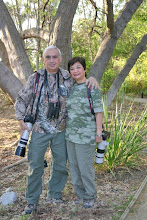It had been an unproductive three-and-a-half hours that Monday morning at the La Mesa Ecopark. When our friend Peter texted me a little before 9 am asking if there were any birds, I promptly and tersely replied: not much.
Not a single Ashy Thrush nor Mangrove Blue Flycatcher showed up. The hoped for kingfishers - the Indigo-banded and Spotted Wood - were likewise absent. Our main target though was the Brown-headed Thrush. And indeed we saw it as it was about to feed on the bright red fruits of the MacArthur palm. Unfortunately as I was about to take its picture, the hood of my 100-400 lens fell producing a clanking sound which spooked the thrush. (Note: This time I opted for my smaller lens instead of the heavy 500 simply because I wasn't in the mood to carry such a load on my shoulders. There were bad and good consequences from this decision as I shall relate later.)
About 9:30 Peter joined us and we staked out the area where the tiny kingfisher was supposed to be seen. With the presence of bullying Philippine Magpie Robins and Philippine Pied Fantails, we knew our quarry would not be showing up anytime soon. We suggested to Peter that we go to the fruiting MacArthur palm and maybe the thrush would be more obliging.
Cynthia and I originally planned to leave at around 10 because she wanted to go to Antipolo for some business. At a quarter before ten, we told Peter that we would be leaving soon. It was then that there were some movement at the palm tree. I looked and was dismayed to see only a Yellow-vented Bulbul. "YVB," I told my companions. Then as I was peering through my camera lens, "Brown-headed Thrush!" "It's there just below the YVB!" I could hardly contain my excitement as I informed Peter and my wife.
This was the bad side of my short lens. Because I was just handholding it and the lens wasn't that good at dimly lit situations I only had so-so photos of the bird we came here to see.
After the Brown-headed Thrush left, we got ready to return to the parking lot. Peter suggested we stop by the spillway first. We agreed. Besides, Cynthia's appointment had already been rescheduled so we could stay a bit longer here.
At the spillway, we met fellow bird photographer Speed Reyes who told us that he had seen a Philippine Serpent Eagle dive down to the stream below. I was a bit skeptical since it didn't seem normal for that species to be doing that.
Again, aside from a couple of Barred Rails and a single White-breasted Waterhen, there were no other birds there. I was about to tell Cynthia that we should be going when a huge bird flew down to the stream below. "Raptor!" I shouted. It was, surprisingly, the Philippine Serpent Eagle, just as Speed had said. We took pictures as the raptor just stood there.
We then braced ourselves for a possible BIF (bird in flight) shot as we anticipated the Serpent Eagle to return to its roost. When it did, it was Cynthia who got the shot.
It settled on the branch of an acacia tree across the spillway, way too far for my and Cynthia's feeble lenses. But for Peter's 600mm plus extender, it was just perfect. After that encounter my wife and I were about to go back to our car when I saw another huge bird flying over the spillway. My shout of "Raptor!" once again filled the air. This time my smaller lens had the advantage as I was able to track the flight of the Crested Honey Buzzard.
By the time Peter was able to move his gear to a more open space, the buzzard was already gone. Then.."Raptor!" I shouted for the third time as another fly by occurred albeit at a farther distance. This time it was an Osprey and I was able to get some good shots at it, again thanks to a lighter lens.
On the way home, my wife was telling me how all of a sudden we had a plethora of birds just as we were about to leave.
Perhaps, God was saving the best for last, I told her.
She couldn't agree more.
Unhurried grace . . . 🐊
1 day ago








2 comments:
Nice! I have yet to see the Buzzard at LMEP.
Very interesting post! Well, we can never know what to expect when out birding.
Post a Comment